少儿英语语法教学法 英文版
- 格式:ppt
- 大小:612.50 KB
- 文档页数:20
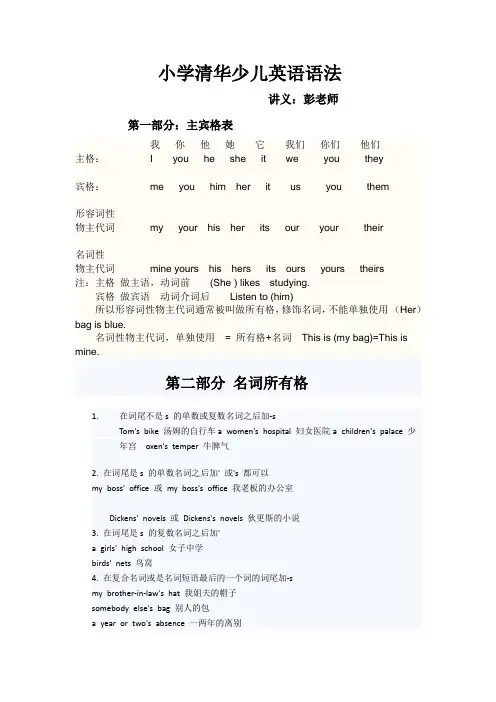
小学清华少儿英语语法讲义:彭老师第一部分:主宾格表我你他她它我们你们他们主格:I you he she it we you they宾格:me you him her it us you them形容词性物主代词my your his her its our your their名词性物主代词mine yours his hers its ours yours theirs注:主格做主语,动词前(She ) likes studying.宾格做宾语动词介词后Listen to (him)所以形容词性物主代词通常被叫做所有格,修饰名词,不能单独使用(Her)bag is blue.名词性物主代词,单独使用= 所有格+名词This is (my bag)=This is mine.第二部分名词所有格1.在词尾不是s 的单数或复数名词之后加-sTom's bike 汤姆的自行车a women's hospital 妇女医院a children's palace 少年宫oxen's temper 牛脾气2. 在词尾是s 的单数名词之后加' 或's 都可以my boss' office 或my boss's office 我老板的办公室Dickens' novels 或Dickens's novels 狄更斯的小说3. 在词尾是s 的复数名词之后加'a girls' high school 女子中学birds' nets 鸟窝4. 在复合名词或是名词短语最后的一个词的词尾加-smy brother-in-law's hat 我姐夫的帽子somebody else's bag 别人的包a year or two's absence 一两年的离别the President of America's car 美国总统的座车但是,最后一个词的词尾若是s ,只加'go-betweens' arrangements 中间人的安排5. 名词之后有同位语时,将同位语变成所有格Have you seen my sister, Mary's bike? 你有没有看见我姐姐玛丽的自行车?6. 共同拥有或是个别拥有的区别Mary and Betty's parents(两人父母相同)Mary's and Betty's parents(两人各自的父母)John and Mary's school(两人同在一所学校)John's and Mary's schools(两人分别在不同的学校)7. "of + 名词"构成的所有格the door of the room 房间的门the tittle of the film 影片的名字第三部分‘S 和OF 的区别一、“'s 所有格”的用1. 表示人、由人组成的集体、动物真正所有的:the boy's mother 男孩的母亲2. 表示时间:a day's journey 一天的旅程3. 表示自然现象:the moon's rays 月光4. 表示国家、城市等实体:the city's park 城市的公园5. 表示工作群体:the ship's crew 船上的工作人员6. 表示度量衡及价值:a mile's distance 一英里的距离7. 表示拟人化:Nature's works 大自然的作品sorrow's tear 悲哀的泪水二、“of结构”的用法1. 用于无生命的东西:the rocket of the space shuttle 航天飞机的火箭2. 用于名词化的词:the livelihood of the poor 穷人的生计3. 修饰语较多时:the tail of the old black cat 老黑猫的尾巴4. 为避免出现“所有格+所有格+名词”的结构:the father of my father's father 我祖父的父亲5. 用于代词宾格之前:three of them 他们当中的三人第四部分,Be 动词的用法:(1) Am--was Is --was Are--were 口诀:我用am, 你用are, is用在他她它,复数全用are。

少儿英语语法知识点讲解少儿英语语法中,我们应该知道的从句语顺口溜和知识点。
下面是店铺给大家整理的少儿英语语法,供大家参阅!少儿英语语法:特殊定语从句只记上边不可以,特殊情况告诉你;先行用way 做状语, in which/ that /略可以,先行词是way, 表示方式,在定语从句中做方式状语,其后的关系词可以有三种处理方式,即:in which/ that或省略。
例句:I like the way he smiles.I like the way that he smiles.I like the way in which he smiles.one of +复做先行,从中谓语复数明,one前若有only/ very, 从中谓语定用单;例句:Ling Qing is one of the volunteers who are ready to go to the countryside.Ling Qing is the only one of the volunteers who is ready to go to the countryside.定从名从可转换,all that被 what换;名词性从句中的what/whatever/whoever等词,在句中做主语、宾语或表语时,可以转换成定语从句。
例句:1) I don’t believe whatever he says.= I don't believe anything (that) he says.2) Whoever breaks the law will be punished.= Anyone who breaks the law will be punished.3) The driver didn’t hear what the policeman said. = The driver didn’t hear the words that thepoliceman said.4) The students can do all (that) they can to help the oldteacher. = The students can do whatthey can to help the old teacher.少儿英语语法:定语从句中的whose指人可用that who, 以下情况多用who;Those people做先行,There be的结构中;例句:1) Those who are for the plan, please raise your hands.赞成计划的人请举手。

有效的少儿英语教学方法IntroductionThe Most Effective Methods for Teaching English to Children1. StorytellingStorytelling is one of the most effective and engaging methods for teaching English to children. Stories provide a context that children can relate to, and help them to understand and remember new concepts. By using stories as a tool for teaching English, children can gain an understanding of grammar and sentence structure in a fun and engaging way.2. GamesGames are a great way to get children to practice their English skills in a fun and stimulating way. There are a variety of language games available, such as board games, card games, and interactive online games. Games help children to learn and reinforce vocabulary, grammar, and pronunciation.3. Music and SongsSinging is a great way to make learning more fun and enjoyable for children. Music and songs can help children learn new words, phrases, and grammar structures in a fun and engaging way. Children often remember words and phrases more easily with the help of music.4. Visual AidsVisual aids are an effective tool for teaching English to children. By using visual aids such as pictures, charts, and videos, children can gain a better understanding of the language. Visual aids also help children to remember new words and phrases more easily.5. Creative WritingCreative writing is a great way to get children to practice their English skills in a creative and engaging way. Creative writing activities such as writing stories, poems, and songs can help children explore their imagination while using English.ConclusionIn conclusion, there are many effective methods for teaching English to children. By using storytelling, games, music and songs, visual aids, and creative writing, children can gain a better understanding of the English language in a fun and engaging way. With the proper tools and techniques, teaching English to children can be a rewarding and enjoyable experience.。
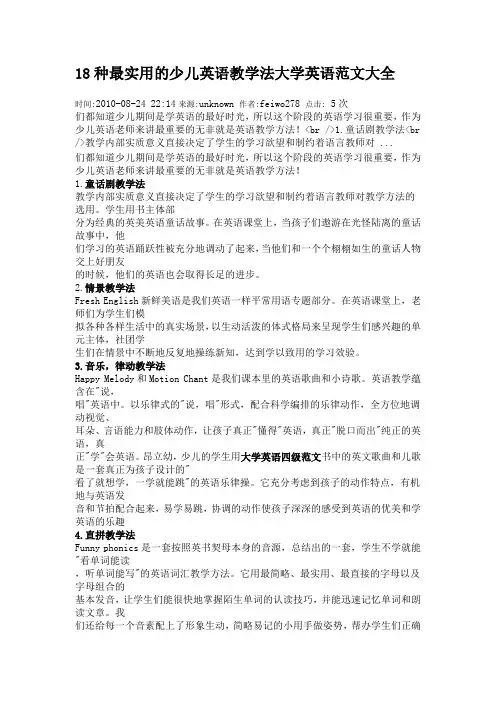
18种最实用的少儿英语教学法大学英语范文大全时间:2010-08-24 22:14来源:unknown 作者:feiwo278 点击:5次们都知道少儿期间是学英语的最好时光,所以这个阶段的英语学习很重要,作为少儿英语老师来讲最重要的无非就是英语教学方法!<br />1.童话剧教学法<br />教学内部实质意义直接决定了学生的学习欲望和制约着语言教师对 ...们都知道少儿期间是学英语的最好时光,所以这个阶段的英语学习很重要,作为少儿英语老师来讲最重要的无非就是英语教学方法!1.童话剧教学法教学内部实质意义直接决定了学生的学习欲望和制约着语言教师对教学方法的选用。
学生用书主体部分为经典的英美英语童话故事。
在英语课堂上,当孩子们遨游在光怪陆离的童话故事中,他们学习的英语踊跃性被充分地调动了起来,当他们和一个个栩栩如生的童话人物交上好朋友的时候,他们的英语也会取得长足的进步。
2.情景教学法Fresh English新鲜美语是我们英语一样平常用语专题部分。
在英语课堂上,老师们为学生们模拟各种各样生活中的真实场景,以生动活泼的体式格局来呈现学生们感兴趣的单元主体,社团学生们在情景中不断地反复地操练新知,达到学以致用的学习效验。
3.音乐,律动教学法Happy Melody和Motion Chant是我们课本里的英语歌曲和小诗歌。
英语教学蕴含在"说,唱"英语中。
以乐律式的"说,唱"形式,配合科学编排的乐律动作,全方位地调动视觉、耳朵、言语能力和肢体动作,让孩子真正"懂得"英语,真正"脱口而出"纯正的英语,真正"学"会英语。
昂立幼,少儿的学生用大学英语四级范文书中的英文歌曲和儿歌是一套真正为孩子设计的"看了就想学,一学就能跳"的英语乐律操。
它充分考虑到孩子的动作特点,有机地与英语发音和节拍配合起来,易学易跳,协调的动作使孩子深深的感受到英语的优美和学英语的乐趣4.直拼教学法Funny phonics是一套按照英书契母本身的音源,总结出的一套,学生不学就能"看单词能读,听单词能写"的英语词汇教学方法。
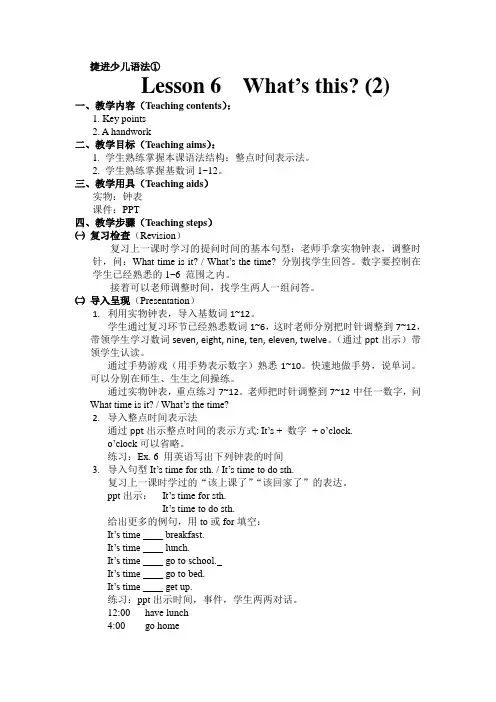
捷进少儿语法①Lesson 6 What’s this? (2)一、教学内容(Teaching contents):1. Key points2. A handwork二、教学目标(Teaching aims):1. 学生熟练掌握本课语法结构:整点时间表示法。
2. 学生熟练掌握基数词1~12。
三、教学用具(Teaching aids)实物:钟表课件:PPT四、教学步骤(Teaching steps)㈠复习检查(Revision)复习上一课时学习的提问时间的基本句型:老师手拿实物钟表,调整时针,问:What time is it? / What’s the time? 分别找学生回答。
数字要控制在学生已经熟悉的1~6 范围之内。
接着可以老师调整时间,找学生两人一组问答。
㈡导入呈现(Presentation)1.利用实物钟表,导入基数词1~12。
学生通过复习环节已经熟悉数词1~6,这时老师分别把时针调整到7~12,带领学生学习数词seven, eight, nine, ten, eleven, twelve。
(通过ppt出示)带领学生认读。
通过手势游戏(用手势表示数字)熟悉1~10。
快速地做手势,说单词。
可以分别在师生、生生之间操练。
通过实物钟表,重点练习7~12。
老师把时针调整到7~12中任一数字,问What time is it? / What’s the time?2.导入整点时间表示法通过ppt出示整点时间的表示方式: It’s + 数字+ o’clock.o’clock可以省略。
练习:Ex. 6 用英语写出下列钟表的时间3.导入句型It’s time for sth. / It’s time to do sth.复习上一课时学过的“该上课了”“该回家了”的表达。
ppt出示:It’s time for sth.It’s time to do sth.给出更多的例句,用to或for填空:It’s time ____ breakfast.It’s time ____ lunch.It’s time ____ go to school.It’s time ____ go to bed.It’s time ____ get up.练习:ppt出示时间,事件,学生两两对话。
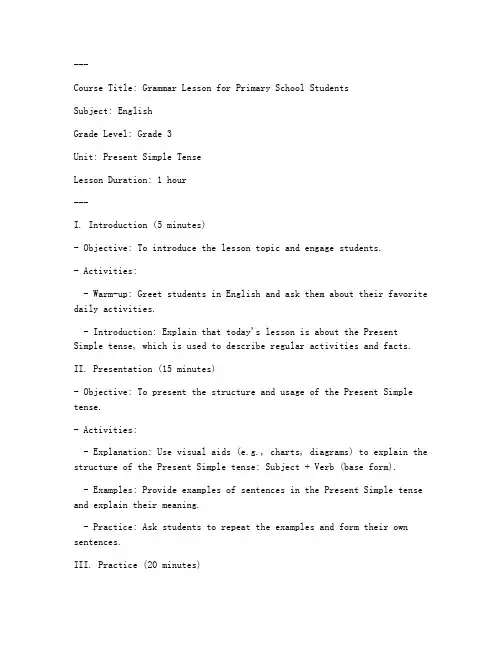
---Course Title: Grammar Lesson for Primary School StudentsSubject: EnglishGrade Level: Grade 3Unit: Present Simple TenseLesson Duration: 1 hour---I. Introduction (5 minutes)- Objective: To introduce the lesson topic and engage students.- Activities:- Warm-up: Greet students in English and ask them about their favorite daily activities.- Introduction: Explain that today's lesson is about the Present Simple tense, which is used to describe regular activities and facts.II. Presentation (15 minutes)- Objective: To present the structure and usage of the Present Simple tense.- Activities:- Explanation: Use visual aids (e.g., charts, diagrams) to explain the structure of the Present Simple tense: Subject + Verb (base form).- Examples: Provide examples of sentences in the Present Simple tense and explain their meaning.- Practice: Ask students to repeat the examples and form their own sentences.III. Practice (20 minutes)- Objective: To practice using the Present Simple tense in different contexts.- Activities:- Workbook Activities: Assign exercises from the workbook related to the Present Simple tense.- Pair Work: Divide the class into pairs and ask them to complete a worksheet together, focusing on using the Present Simple tense correctly.- Group Discussion: Have students discuss their daily routines and write sentences in the Present Simple tense to describe them.IV. Game Time (10 minutes)- Objective: To reinforce learning through a fun activity.- Activities:- Grammar Game: Play a game like "Simon Says" where students must perform actions only when instructed in the Present Simple tense.- Memory Game: Create cards with sentences in the Present Simple tense on one side and their corresponding pictures on the other. Students have to match the sentences with the correct pictures.V. Consolidation (10 minutes)- Objective: To review and consolidate the learning from the lesson.- Activities:- Flashcards: Use flashcards with Present Simple tense sentences for a quick review.- Writing Exercise: Have students write a short paragraph describing their favorite pastime using the Present Simple tense.VI. Homework (5 minutes)- Objective: To extend learning outside the classroom.- Assignment: Assign a homework task that involves writing sentences in the Present Simple tense to describe daily activities or routines.---VII. Assessment- Formative Assessment: Observe students' participation, engagement, and ability to use the Present Simple tense correctly during the lesson.- Summative Assessment: Evaluate the homework and workbook exercises to determine students' understanding of the Present Simple tense.---Note: This template can be adapted to different grammar topics and grade levels. Adjust the activities and duration according to the needs and abilities of the students.。

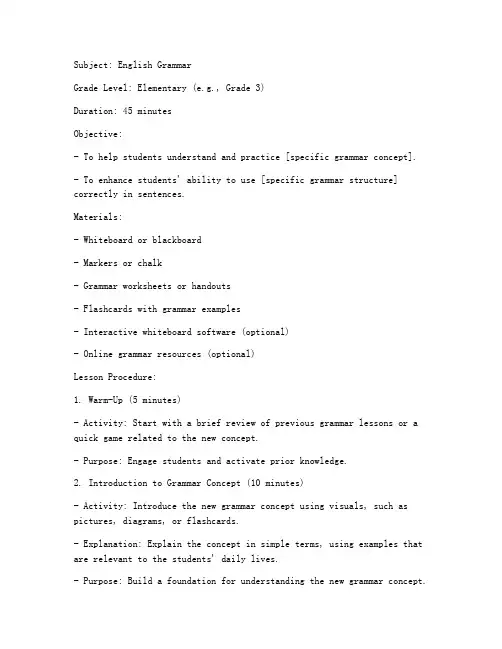
Subject: English GrammarGrade Level: Elementary (e.g., Grade 3)Duration: 45 minutesObjective:- To help students understand and practice [specific grammar concept].- To enhance students' ability to use [specific grammar structure] correctly in sentences.Materials:- Whiteboard or blackboard- Markers or chalk- Grammar worksheets or handouts- Flashcards with grammar examples- Interactive whiteboard software (optional)- Online grammar resources (optional)Lesson Procedure:1. Warm-Up (5 minutes)- Activity: Start with a brief review of previous grammar lessons or a quick game related to the new concept.- Purpose: Engage students and activate prior knowledge.2. Introduction to Grammar Concept (10 minutes)- Activity: Introduce the new grammar concept using visuals, such as pictures, diagrams, or flashcards.- Explanation: Explain the concept in simple terms, using examples that are relevant to the students' daily lives.- Purpose: Build a foundation for understanding the new grammar concept.3. Interactive Demonstration (10 minutes)- Activity: Use the interactive whiteboard or blackboard to demonstrate the grammar concept with the help of examples.- Explanation: Write or type sentences on the board, using the new grammar structure, and explain each part of the sentence.- Purpose: Provide a visual and interactive way to understand the concept.4. Guided Practice (10 minutes)- Activity: Pair students up or create small groups to practice the grammar concept through exercises or activities.- Instructions: Provide a worksheet or handout with exercises related to the new grammar concept.- Purpose: Reinforce the concept through practice and collaboration.5. Independent Practice (10 minutes)- Activity: Give students a few minutes to complete additional exercises independently.- Instructions: Students can work on their own or in pairs to complete the exercises.- Purpose: Allow students to practice the concept independently and reinforce their learning.6. Review and Consolidation (5 minutes)- Activity: Conduct a quick review of the lesson by asking students to share their answers or sentences they have written.- Explanation: Go over any common errors or misunderstandings.- Purpose: Reinforce the key points of the lesson and ensure students understand the concept.7. Homework Assignment (5 minutes)- Activity: Assign a homework task that reinforces the new grammar concept.- Instructions: Provide clear instructions and an example if necessary.- Purpose: Extend learning beyond the classroom and provide additional practice.Assessment:- Formative Assessment: Observe students during the lesson and check their understanding through class participation, group activities, and individual exercises.- Summative Assessment: Collect and review homework assignments and provide feedback to students.Reflection:- Teacher Reflection: After the lesson, reflect on the effectiveness of the teaching methods used and consider any adjustments that could be made for future lessons.- Student Reflection: Encourage students to reflect on their learning by writing a short paragraph about what they learned and how they feel about their progress.Additional Notes:- Ensure that the lesson is tailored to the students' age and level of understanding.- Use a variety of teaching methods to cater to different learning styles.- Be patient and supportive, as grammar can be challenging for some students.- Celebrate students' progress and achievements.。
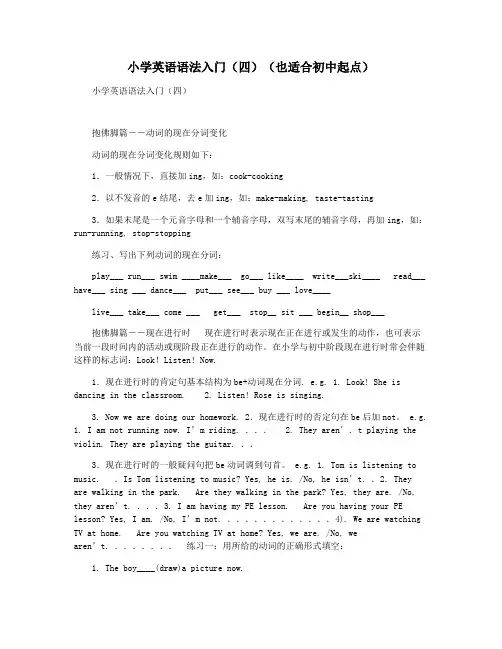
小学英语语法入门(四)(也适合初中起点)小学英语语法入门(四)抱佛脚篇――动词的现在分词变化动词的现在分词变化规则如下:1.一般情况下,直接加ing,如:cook-cooking2.以不发音的e结尾,去e加ing,如:make-making, taste-tasting3.如果末尾是一个元音字母和一个辅音字母,双写末尾的辅音字母,再加ing,如:run-running, stop-stopping练习、写出下列动词的现在分词:play___ run___ swim ____make___ go___ like____ write___ski____ read___ have___ sing ___ dance___ put___ see___ buy ___ love____live___ take___ come ___ get___ stop__ sit ___ begin__ shop___抱佛脚篇――现在进行时现在进行时表示现在正在进行或发生的动作,也可表示当前一段时间内的活动或现阶段正在进行的动作。
在小学与初中阶段现在进行时常会伴随这样的标志词:Look!Listen! Now.1.现在进行时的肯定句基本结构为be+动词现在分词. e.g. 1. Look! She is dancing in the classroom. 2. Listen! Rose is singing.3. Now we are doing our homework. 2.现在进行时的否定句在be后加not。
e.g.1. I a m not running now. I’m riding. ...2. They aren’.t playing the violin. They are playing the guitar. ..3.现在进行时的一般疑问句把be动词调到句首。
e.g. 1. Tom is listening to music. .Is Tom listening to music? Yes, he is. /No, he isn’t. .2. Theyare walking in the park. Are they walking in the park? Yes, they are. /No, they aren’t. ...3. I am having my PE lesson. Are you having your PE lesson? Yes, I am. /No, I’m not. ............4). We are watching TV at home. Are you watching TV at home? Yes, we are. /No, wear en’t. .......练习一:用所给的动词的正确形式填空:1. The boy____(draw)a picture now.2. Listen .Some girls__(sing)in the classroom.3. My mother__ cook)somenice food now. 4. What__you__(do) now?5. Look. They__(have)an English lesson.6. They ____________(not ,water) the flowers now.7. Look! The girls ________________(dance )in the classroom .8. What is our granddaughter doing? She _________(listen ) to music. 9.It’s 5 o’clock now. We__(have)supper now. 10.__Helen___(wash)clothes?Yes ,she is. 练习二:句型转换:1. They are doing housework .(分别改成一般疑问句和否定句)2.The students are cleaning the classroom . (改一般疑问句并作肯定和否定回答) 3.I’m playing the football on the playground .(对划线部分进行提问)4.Tom is reading books in his study . (对划线部分进行提问)抱佛脚篇――动词的单三变化1. 一般在动词词尾加s,e.g. collect collects play plays2. 以s, x, sh, ch, o结尾的动词加es,e.g. miss misses watch watches go goes3. 以一个辅音字母加y结尾的动词,变y为i再加es,e.g. carrycarries 4. 特殊:have has5. 单三读音规则:清后????浊元?????????????????????后发??????e.g. come????? comes??????? stay??????stays??????? pass?????? passes?????????? catch?????? catches??????????练习:将下列动词变成单三形式drink ____ go ____ stay _____ make _____look ____ have___ pass____ carry____ come____ watch____ plant____ fly ____study___ brush___ do___ teach___ brush___抱佛脚篇――一般现在时一般现在时表示经常性或习惯性的动作。


Subject: English GrammarGrade Level: Primary (e.g., Grade 3)Class Duration: 40 minutesLesson Objective:To teach students the basic structure of simple sentences and how to form them using a subject and a predicate.Teaching Aids:- Whiteboard and markers- Handouts with examples- Flashcards with subjects and predicates- Small whiteboards for individual practice- Pencils and erasers for writing exercisesWarm-up (5 minutes):1. Greeting and Review: Greet the students and review the previous lesson's vocabulary and grammar points briefly.2. Interactive Activity: Use a quick game, such as "Simon Says," to practice simple commands that involve basic vocabulary from the previous lesson.Introduction (5 minutes):1. Topic Introduction: Introduce the topic of simple sentences and explain that they are the basic building blocks of a sentence in English.2. Explanation: Explain that a simple sentence has a subject (who or what the sentence is about) and a predicate (what the subject does or what happens to the subject).Teaching (15 minutes):1. Examples on the Whiteboard:- Write a simple sentence on the whiteboard and explain its structure.- Break down the sentence into its subject and predicate and discuss the meaning of each part.- Provide more examples and have students identify the subject and predicate in each sentence.2. Flashcards Activity:- Hand out flashcards with subjects and predicates to students.- Ask students to match the correct subject with the appropriate predicate to form a simple sentence.3. Interactive Practice:- Use a game show format where students come up to the whiteboard to write a simple sentence using a given subject and predicate.- Praise students for correct answers and provide feedback for incorrect ones.Practice (10 minutes):1. Pair Work:- Pair students up and give each pair a handout with a list of subjects and predicates.- Instruct them to create as many simple sentences as possible using the provided words.2. Individual Practice:- Provide small whiteboards and pencils for individual practice.- Have students write a simple sentence on their whiteboard, then hold it up for the teacher to check.- Correct any mistakes and provide positive reinforcement for correct sentences.Feedback and Review (5 minutes):1. Class Discussion:- Ask students to share the sentences they created during thepractice session.- Discuss the structure of each sentence and whether they followed the subject-predicate rule.2. Quiz:- Conduct a quick quiz to assess understanding of the lesson's main concept.- Use multiple-choice questions or true/false statements related to simple sentences.Homework Assignment:1. Writing Assignment:- Assign students to write a short paragraph using at least five simple sentences.- Encourage them to use different subjects and predicates to create a variety of sentences.Assessment:- Observe students' participation in class activities and their ability to create simple sentences.- Review homework assignments to assess their understanding and application of the subject-predicate structure.Follow-up Activities:- Plan a future lesson that builds upon this one, focusing on more complex sentence structures.- Consider incorporating technology, such as educational apps or online games, to reinforce grammar concepts.。
小学英语语法教案教案1:Level: Primary SchoolSubject: EnglishGrammar Topic: Simple Present TenseObjectives:1. Students will understand the concept of simple present tense.2. Students will be able to form affirmative and negative sentences using the simple present tense.3. Students will practice using the simple present tense in conversations.Materials:- Whiteboard and markers- Flashcards with pictures of daily activities- Worksheet with fill-in-the-blank sentencesProcedure:1. Warm-up (5 minutes):- Greet the students and ask them how they are doing.- Play a quick game of Simon Says to review different action verbs (e.g. jump, clap, touch your nose).2. Introduction (10 minutes):- Write a sentence on the board, e.g. "I play soccer." Ask students to identify the verb and tenses used.- Explain that the simple present tense is used to talk about habits, routines, and general truths.- Provide more examples of sentences in the simple present tense,e.g. "He eats breakfast every morning."3. Grammar Explanation (10 minutes):- Write the structure of affirmative and negative sentences using the simple present tense.- Show flashcards with pictures of different activities and elicit sentences from the students using the simple present tense.- Ask students to identify the subject, verb, and any additional words in each sentence.4. Practice Activity (15 minutes):- Distribute the worksheet with fill-in-the-blank sentences for students to complete using the simple present tense.- Monitor the students as they work and provide assistance if needed.- Check the answers as a class and discuss any mistakes or common difficulties.5. Application (10 minutes):- Divide the students into pairs or small groups.- Ask them to have a short conversation with their partner using the simple present tense.- Encourage students to ask questions and provide answers using the appropriate verbs and tenses.6. Conclusion (5 minutes):- Recap the main points of the lesson, emphasizing the use of simple present tense.- Answer any remaining questions and provide feedback to the students.Extension Activity:- Ask students to write a short paragraph about their daily routine using the simple present tense.。
幼儿园英语教学之语法教案课题:幼儿园英语教学之语法教学目标:1. 学习英语基本的语法规则和术语;2. 理解英语语法与句子结构的关系;3. 练习英语的语法和句式,提高英语口语和阅读能力。
教学重点:1. 英语语法基本规则的讲解和理解;2. 英语句式的练习和应用。
教学难点:1. 英语语法在幼儿园阶段的教学和应用;2. 学生理解英语语法规则后的口语和阅读提高。
教学过程:Step 1:Warm-up1. Greetings: Teacher and students greet each other, saying “Good morning, teacher/Good morning, students”.2. Welcome them to the English class and ask them if they remember what they learned in the previous lesson.3. Introduce the topic of today’s lesson.Step 2:Presentation1. Introduce basic English grammar rules (such as verb conjugation, subject-verb agreement, adjective and adverb usage, etc.) using simple language to make it easy for students to understand.2. Teach them common English phrases and encourage students to practice their pronunciations.3. Provide visual aids (such as pictures and diagrams) to assist in teaching.Step 3:Practice1. Have students practice forming sentences using the grammar rules they’ve learned.2. Conduct sentence building activities.3. Ask students to work in groups and create conversations using the targeted grammar.Step 4:Production1. Have students to create their own stories using the grammarrules they’ve learned.2. Have students rewrite passages from their textbook or storybooks, applying the grammar to improve sentence structure and clarityStep 5:Closure1. Ask students to summarize what they learned in the class today, and give a brief explanation of the grammar rules they just learned.2. Provide positive feedback and remind them to continue practicing English grammar in their daily lives.Step 6:Homework1. Assign homework for the students to apply the grammar rules they just learned in a written project.2. Encourage students to read English stories or articles to further improve their understanding of the language.教学资料:1. Pictures and diagrams to help simplify grammar rules.2. Handouts of common English phrases and sentences.3. Pen and paper for activities and writing exercises.教学评估:1. Evaluate each student’s ability to appl y the grammar rules they just learned through spoken and written exercises.2. Observe students’ confidence in using new language structures in conversations and reading activities.教学扩展:1. Further explore English grammar rules with more complex structures.2. Provide reading materials to promote further discussion and practice of language structures and common grammar mistakes.。